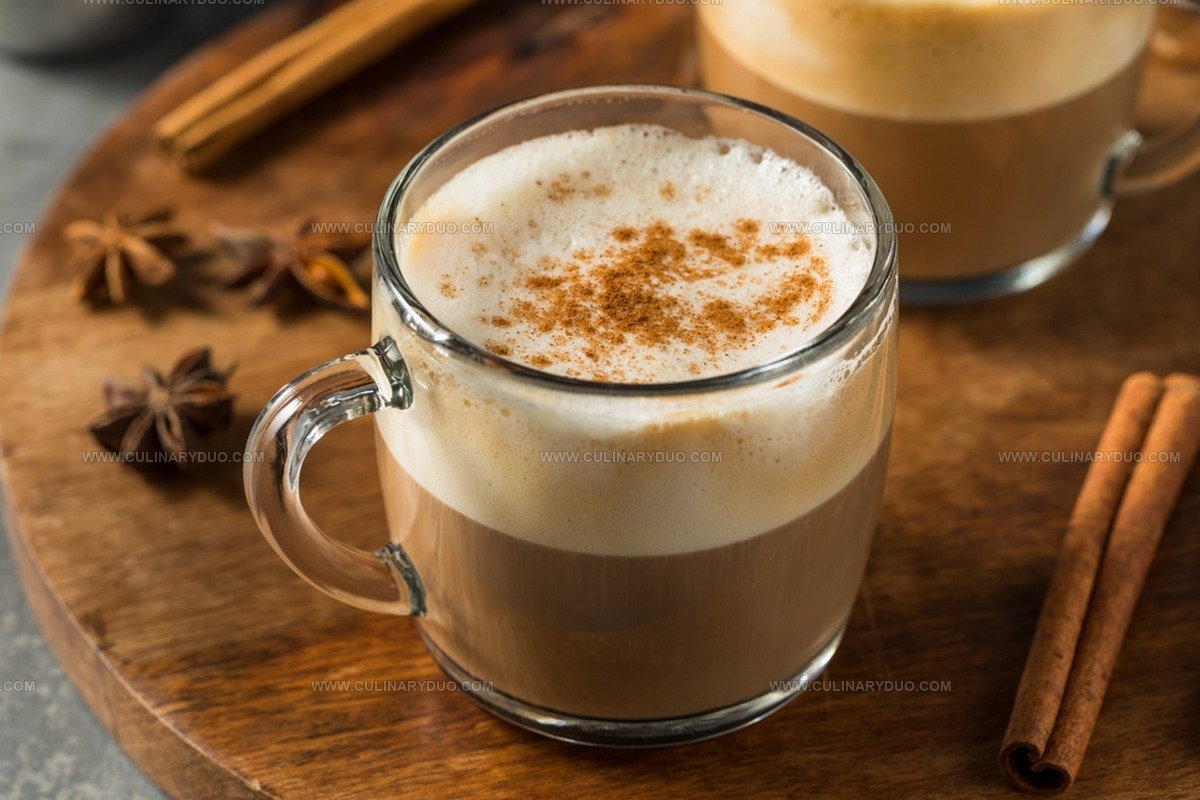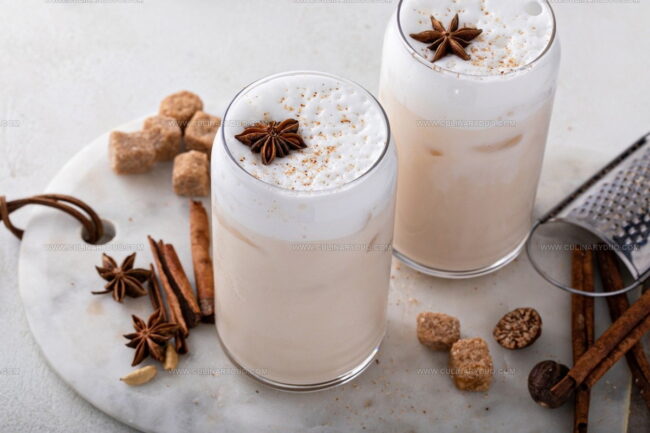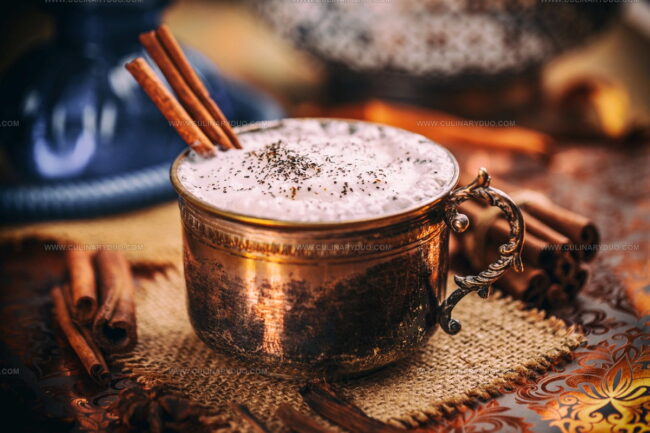What Does Chai Latte Taste Like? A Warm Hug in a Mug!
Chai lattes have become a beloved beverage for many coffee shop enthusiasts seeking a unique and comforting drink.
This aromatic blend of spices and tea offers a complex flavor profile that goes beyond typical beverages.
Warm and inviting, chai lattes combine traditional Indian tea-making techniques with modern café culture.
Spice lovers and tea drinkers find themselves drawn to its rich, multilayered sensory experience.
The combination of black tea, fragrant spices, and creamy milk creates a drink that tantalizes the senses.
Some people describe chai lattes as a hug in a mug, offering warmth and comfort with every sip.
Your curiosity about this popular drink is about to be satisfied through a delightful journey of flavor exploration.
What Is a Chai Latte?
Chai latte and chai tea often confuse tea enthusiasts.
Slight differences set these two drinks apart, with chai latte being a modern take on traditional chai tea.
Preparation methods create unique flavor profiles for each beverage.
Chai latte tends to be sweeter, packed with extra sugar, sweeteners, and topped with whipped cream.
Traditional chai tea typically uses warm milk, while chai latte features frothed milk.
Concentrated spiced tea gives chai latte a more intense flavor compared to standard masala chai tea.
Steamed milk creates a lighter texture that sets it apart from regular chai tea.
Each serving includes a light, airy froth layer that adds a creamy richness to the drink.
Milk selection plays a key role in chai latte's smooth texture.
Dense plant-based milks like macadamia or cashew create a thick, rich mouthfeel.
Lighter options such as almond and soy milk result in a more delicate chai latte experience.
Chai Latte Taste Guide
Chai latte offers a blend of flavors for tea and coffee lovers.
Brewed black tea mixed with milk, sugar, and warming spices creates this special drink.
Typical spice combinations include cinnamon, ginger, and cardamom, which add rich depth to the beverage.
Milk blends smoothly with the tea, giving the drink a creamy and smooth texture.
Flavor profiles mix coffee and chai tea elements.
Cafe versions can differ slightly, with each spot adding its own special touch.
Checking out local cafes helps you understand the unique characteristics of different chai latte styles.
Drink variations include clean and dirty options.
Clean latte contains no caffeine, while dirty latte brings extra aromatic notes.
Coffee versions tend to have a smokier taste.
Trying both styles lets you discover your personal preference.
Origins of chai latte come from traditional Indian beverages.
Unique spice combinations create a rich and complex drink.
Steamed milk changes the texture, with heavier milk making a thicker drink.
Light milk produces a more airy and smooth experience.
Compared to regular chai tea, chai latte feels more concentrated.
Creamy foam sits on top of the drink, making it look and taste special.
Serving temperature matters - room temperature works best.
Chai latte works well as a morning pick-me-up or a sweet afternoon treat.
Traditional Chai vs. Chai Latte: Flavor Differences
Traditional chai and chai latte both use tea and spices, but they offer different flavor experiences thanks to how they’re made:
The flavor is bold, spicy, and aromatic, with the spices taking center stage and just enough sweetness to balance the strong tea.
It’s often sweeter and creamier, with a milder taste and softer spice notes.
Many coffee shops use pre-made chai concentrate, which can make the drink taste sweeter and less complex than homemade chai.
In short, traditional chai is robust, spicy, and tea-forward, while chai latte is smoother, milkier, and more softly spiced, perfect for those who prefer a gentler, sweeter sip.
Modern Chai Latte and Flavors
Modern chai latte stands as a beloved drink across different groups.
Sebastiaan notes no specific population prefers it more than others.
Genuine differences between tea drinkers remain unclear.
Chai serves as a wonderful option for those needing warmth without heavy caffeine.
Baristas appreciate offering a sweet and spicy alternative to standard cappuccinos or lattes.
Zee agrees with Sebastiaan that chai attracts a wide range of customers.
Its broad appeal crosses many social boundaries.
Each coffee shop crafts chai latte with unique recipe tweaks.
Spice variations determine subtle flavor changes.
Current consumers and staff remain satisfied with their chai blend, seeing no urgent need for major adjustments.
Sebastiaan suggests minor presentation modifications can refresh the drink.
Options include adding amaretto for warmth or serving chilled like a milkshake.
Flexible serving styles keep the beverage interesting.
Dirty chai emerges as a notable variation.
Baristas mix a standard chai latte with an espresso shot.
Rumors suggest this combination originated accidentally in London during the 1990s.
Unexpected discoveries often create memorable drink experiences.
Vegan Chai Latte Options
Chai lattes don't always come vegan-friendly.
When ordering at a cafe, skipping the vegan specification means you'll likely receive a drink mixed with cow's milk.
Chai lattes combine chai tea and steamed milk, which could come from a brewed method or condensed mix.
Specifying "vegan" becomes important because of milk ingredients.
Tea bases for chai can also include non-vegan elements.
Some recipes mix in honey or milk products without warning.
Homemade versions might skip these additions, but checking remains smart for anyone following strict dietary choices.
Does Chai Latte Have Coffee?
Chai latte sounds like it has coffee, but it actually doesn't.
Words like "latte" might make you think of espresso, which can be confusing.
Basically, this drink is chai tea mixed with sweetener and warm milk.
Some details get interesting at this point.
Baristas sometimes create a special version called a dirty chai, which includes an espresso shot.
Dirty chai is straightforward: chai tea blended with sugar, steamed milk, and a shot of espresso.
This mix makes the drink slightly more complex and robust compared to a standard sweet chai latte.
Popularity for this version has grown significantly in recent times.
Starbucks Chai Latte Comparison
Starbucks offers chai tea lattes in hot and cold versions.
Spices, sugar, and sweeteners create a sweet and spicy flavor in the hot chai latte.
Starbucks chai latte contains:
Black tea mixes with aromatic spices like cinnamon, cardamom, cloves, and star anise.
Rich ingredients blend sweet and spicy notes in this drink.
Star anise brings a light licorice taste, while cloves add a peppery kick.
Cold chai latte fans can enjoy an iced version that swaps steamed milk for cold milk and adds ice for a chilled, smooth experience.
Making a Chai Latte at Home
This recipe works quickly on the stovetop, and coffee shop fans might prefer using a milk frother for extra authenticity.
My typical method skips fancy tools by whisking milk and spices in a saucepan.
Brewing with tea requires warming almond milk first, then steeping tea bags inside hot milk for 3 to 5 minutes.
After tea bags finish steeping, pull them out and mix in spices and sweetener.
Regular black tea works best to control spice levels, avoiding overly intense chai tea bags.
Sipping this simple drink brings pure comfort and joy in any season.
Cool weather calls for warm sips that satisfy sweet cravings, while summer days welcome chilled versions just as happily.




Natalie Brooks
Co-Founder & Content Strategist
Expertise
Education
eCornell
Natalie brings the vibrant, plant-powered side to Culinary Duo. After earning her Plant-Based Nutrition Certificate from eCornell, she combined her love for fresh ingredients with a passion for storytelling, aiming to make healthy cooking simple and satisfying.
Her kitchen motto: good food doesn’t need a fancy label, it just needs fresh ideas and a little creativity. Outside of writing and recipe testing, Natalie’s happiest in her garden, exploring farmers’ markets, or mixing global flavors into new kitchen experiments.